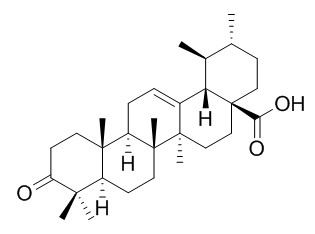Ursonic acid
Ursolic acid, a naturally occurring triterpenoid, induces the apoptosis of human cancer cells through multiple signaling pathways. Ursonic acid has antiviral activity against Herpes simplex virus types I and II in vitro; it also could be used in preparation of depression treatment medicine.
Inquire / Order:
manager@chemfaces.com
Technical Inquiries:
service@chemfaces.com
Tel:
+86-27-84237783
Fax:
+86-27-84254680
Address:
1 Building, No. 83, CheCheng Rd., Wuhan Economic and Technological Development Zone, Wuhan, Hubei 430056, PRC
Providing storage is as stated on the product vial and the vial is kept tightly sealed, the product can be stored for up to
24 months(2-8C).
Wherever possible, you should prepare and use solutions on the same day. However, if you need to make up stock solutions in advance, we recommend that you store the solution as aliquots in tightly sealed vials at -20C. Generally, these will be useable for up to two weeks. Before use, and prior to opening the vial we recommend that you allow your product to equilibrate to room temperature for at least 1 hour.
Need more advice on solubility, usage and handling? Please email to: service@chemfaces.com
The packaging of the product may have turned upside down during transportation, resulting in the natural compounds adhering to the neck or cap of the vial. take the vial out of its packaging and gently shake to let the compounds fall to the bottom of the vial. for liquid products, centrifuge at 200-500 RPM to gather the liquid at the bottom of the vial. try to avoid loss or contamination during handling.
Bioorg Chem.2024, 145:107184.
Antioxidants (Basel).2023, 12(5):1111.
J Food Biochem.2019, 43(9):e12970
Chem Biol Interact.2020, 328:109200.
Phytomedicine.2023, 116:154841.
Biochem Pharmacol. 2020, 177:114014.
J Pharm Biomed Anal.2023, 234:115570.
Int J Mol Sci.2022, 23(20):12516.
J Biochem Mol Toxicol.2017, 31(9)
bioRxiv2021, 458409.
Related and Featured Products
Bioinformation. 2014 Feb 19;10(2):52-5.
Virtual Screening of Indonesian Herbal Database as HIV-1 Protease Inhibitor.[Pubmed:
24616554]
HIV-1 (Human immunodeficiency virus type 1)׳s infection is considered as one of most harmful disease known by human, the survivability rate of the host reduced significantly when it developed into AIDS. HIV drug resistance is one of the main problems of its treatment and several drug designs have been done to find new leads compound as the cure.
METHODS AND RESULTS:
In this study, in silico virtual screening approach was used to find lead molecules from the library or database of natural compounds as HIV-1 protease inhibitor. Virtual screening against Indonesian Herbal Database with AutoDock was performed on HIV-1 protease.
CONCLUSIONS:
From the virtual screening, top ten compounds obtained were 8-Hydroxyapigenin 8-(2",4"-disulfatoglucuronide), Isoscutellarein 4'-methyl ether, Amaranthin, Torvanol A, Ursonic acid, 5-Carboxypyranocyanidin 3-O-(6"-O-malonyl-beta-glucopyranoside), Oleoside, Jacoumaric acid, Platanic acid and 5-Carboxypyranocyanidin 3-O-beta-glucopyranoside.
Phytochemistry. 2005 Feb;66(4):495-501.
Cytotoxic triterpenes from the aerial roots of Ficus microcarpa.[Pubmed:
15694457 ]
Six triterpenes, 3beta-acetoxy-12,19-dioxo-13(18)-oleanene (1), 3beta-acetoxy-19(29)-taraxasten-20alpha-ol (2), 3beta-acetoxy-21alpha,22alpha-epoxytaraxastan-20alpha-ol (3), 3,22-dioxo-20-taraxastene (4), 3beta-acetoxy-11alpha,12alpha-epoxy-16-oxo-14-taraxerene (5), 3beta-acetoxy-25-methoxylanosta-8,23-diene (6) along with nine known triterpenes, 3beta-acetoxy-11alpha,12alpha-epoxy-14-taraxerene (7), 3beta-acetoxy-25-hydroxylanosta-8,23-diene (8), oleanonic acid (9), acetylbetulinic acid (10), betulonic acid (11), acetylursolic acid (12), Ursonic acid (13), ursolic acid (14), and 3-oxofriedelan-28-oic acid (15) were isolated from the aerial roots of Ficus microcarpa, and their structures elucidated by spectroscopic methods.
METHODS AND RESULTS:
The in vitro cytotoxic efficacy of these triterpenes was investigated using three human cancer cell lines, namely, HONE-1 nasopharyngeal carcinoma, KB oral epidermoid carcinoma, and HT29 colorectal carcinoma cells.
CONCLUSIONS:
Compound 8 and pentacyclic triterpenes 9-15 possessing a carboxylic acid functionality at C-28 showed significant cytotoxic activities against the aforementioned cell lines and gave IC50 values in the range 4.0-9.4 microM.
Nat Prod Res. 2015;29(7):628-32.
Two new labdane diterpenoids from the rhizomes of Isodon yuennanensis.[Pubmed:
25420949]
METHODS AND RESULTS:
Two new labdane diterpenoids, s-trans-8(17),12E,14-labdatrien-20-oic acid (1), s-trans-12E,14-labdadien-20,8β-olide (2), along with 10 known compounds, hinokiol (3), Ursonic acid (4), 2α,3α-dihydroxyolean-12-en-28-oic acid (5), 2α,3β,23-trihydroxyolean-12-en-28-oic acid (6), ethyl 3-(3,4-dihydroxyphenyl)lactate (7), ethyl rosmarinate (8), (Z,E)-2-(3,4-dihydroxyphenyl)ethenyl caffeic ester (9), tridecanoic acid (10), β-sitosterol (11) and daucosterol (12), were isolated from the 70% acetone extract of the rhizomes of Isodon yuennanensis.
CONCLUSIONS:
Their structures were elucidated based on the analyses of extensive spectroscopic data and physicochemical properties.



